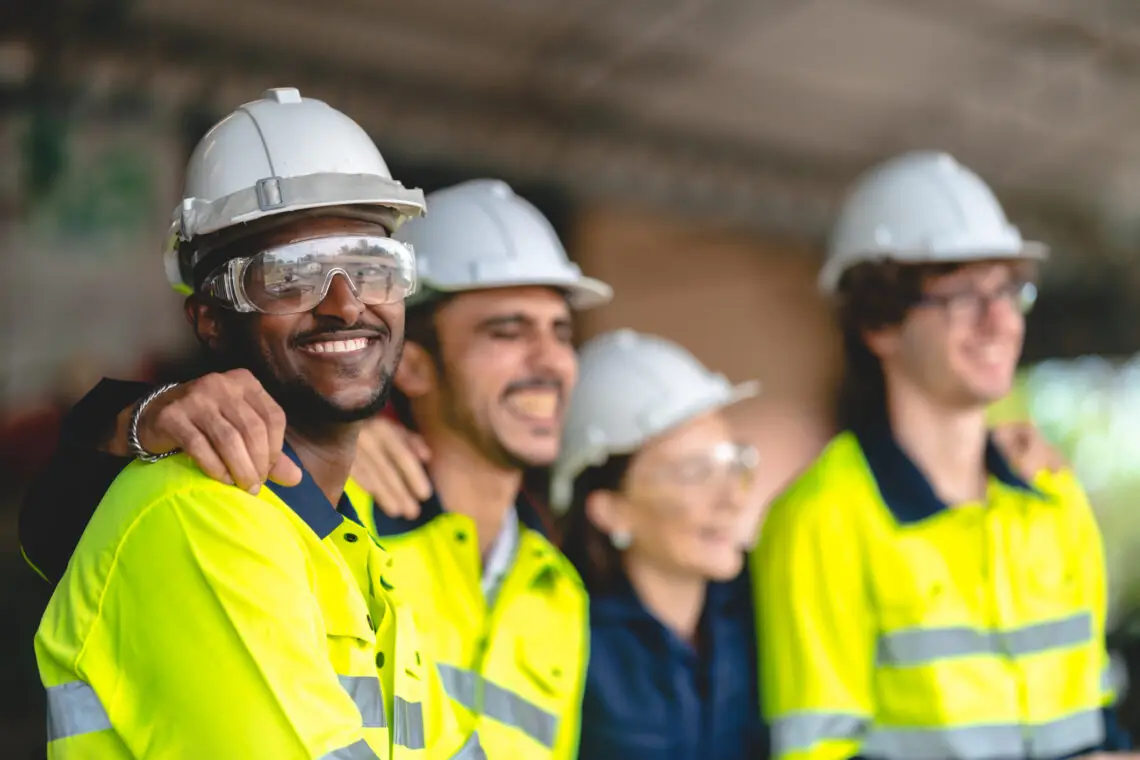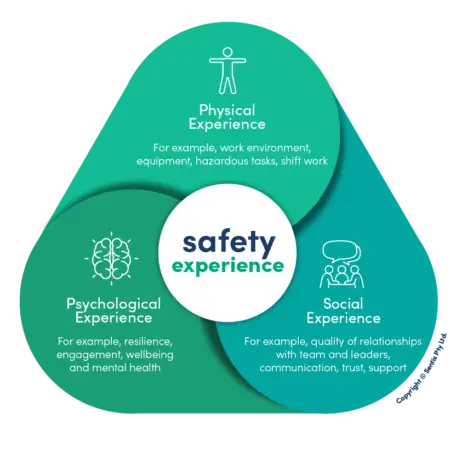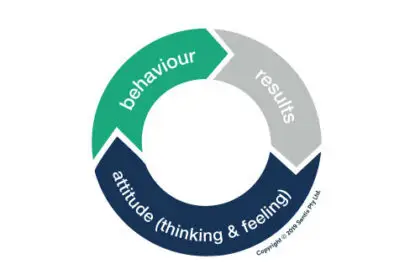If there’s one thing our 20 years of working in the safety industry has taught us, it’s that implementing procedures and supplying the necessary PPE isn’t enough to guarantee a safe workplace.
As part of this holistic view of safety, our team set out to analyse the responses of almost 30,000 employees across a wide range of industries in our latest report, Unpacking Safety Experiences: Employee Perceptions of Safety Climate.
This research investigated the experiences of people on the ground and the interplay between the physical, social and psychological experiences of safety climate.
What we discovered was fascinating – particularly around social safety. While frequently overlooked, we found that the social side of safety had the most positive and the most negative perceptions among employees.
Meaning, when the social experience is going well, it can be a superpower for organisations, and when it’s not, it can be a significant hinderance. This can impact teamwork, mental health and, ultimately, an organisation’s safety performance
To learn what top-performing organisations are doing in this area and where the opportunities lie, keep reading.
The Social Experience
The social experience of safety pertains to our interactions within the workplace. It involves feeling a sense of community, mutual respect and being able to problem-solve as a team. In top-performing organisations the workplace is characterised by clear, positive communication between employees, leaders and across different teams.
A strong social experience indicates a culture of trust and shared responsibility for safety, where individuals feel included and encouraged to contribute. Enhancing this experience moves safety culture beyond a baseline of compliance to one of safety citizenship.
A positive social experience in the workplace means that employees feel a genuine connection to their colleagues and organisation. They feel valued and respected, which in turn fosters a sense of belonging and loyalty.
This kind of environment encourages open communication, where employees are comfortable sharing their concerns and suggestions without fear of retribution. As we’ve found, when employees trust that their input is valued and that their well-being is a priority, they are more likely to engage in safe behaviours and support their peers in doing the same.
The Social Brain
The social brain concept highlights the neurological underpinnings of our social interactions. Positive social experiences trigger the release of hormones like oxytocin and dopamine, which promote feelings of happiness, trust and connection. On the other hand, negative social experiences can trigger stress responses, releasing cortisol and adrenaline, which can undermine mental health and wellbeing.
While there is naturally variability between individuals, looking at how the human brain has evolved to respond to positive and negative social interactions helps us understand which factors might fill or drain the metaphorical ‘bucket’ of social well-being. Positive factors that fill your bucket include feedback, job crafting, autonomy, skill utilisation, social support and adequate resources.
Conversely, negative factors such as emotional demands, a high workload (taking on responsibilities that go beyond your role) and poor leadership can deplete the social bucket.
Organisations can leverage this understanding by creating environments that maximise positive social interactions and minimise stressors. This can involve providing regular constructive feedback, encouraging teamwork and collaboration and ensuring that employees have the resources and autonomy they need to perform their jobs effectively. By doing so, organisations can foster a more supportive and resilient workforce.
The Results: Strengths and Areas for Improvement
From our research, we can see that the social experience of safety had the widest range of results, with the greatest strengths and areas for improvement (compared to the physical and psychological experiences).
The data tells us that strengths are most often found at the team level; individuals accept personal responsibility for safety and feel supported by their peers and supervisors.
Conversely, areas for improvement were mainly found at the organisational level. This involved improving recognition and reward processes, managing mistakes fairly and offering more opportunities for employee input in decision-making.
Strengths
- Team-Level Support: Employees often feel that their immediate team supports their safety efforts. This includes peer support and supervisory encouragement, which are critical for maintaining high safety standards.
- Personal Responsibility: Many employees accept personal responsibility for their safety and the safety of others. This sense of ownership is a key indicator of a mature safety culture.
Areas for Improvement
- Recognition and Reward: While individual teams may perform well, there is often a gap at the organisational level in recognising and rewarding positive safety behaviours. Organisations need to develop systems that consistently acknowledge and reward safety efforts.
- Managing Mistakes: How mistakes are handled can significantly impact the safety culture. Organisations need to move away from blame-based approaches and towards systems that view mistakes as learning opportunities.
- Employee Input: Providing more opportunities for employees to participate in safety-related decision-making can enhance their engagement and commitment to safety practices.
How to Improve the Social Experience in Your Workplace
1. Reward and Recognition
Recognition is a fundamental human need. Effective reward and recognition programs can significantly improve employee performance, engagement, retention and your overall organisational culture.
Recognition should be specific and linked to particular behaviours that align with organisational values. For example, acknowledging an employee who consistently follows safety protocols, reports potential hazards or assists a colleague in maintaining safety standards reinforces the desired behaviours and promotes the kind of culture you want to cultivate.
We also recommend diversifying your recognition methods. While in the right setting, non-monetary rewards such as public acknowledgment, additional time off, or opportunities for professional development can also be highly motivating. What motivates one person might not motivate or apply in every workplace, so get to know your people and tailor your recognition programs accordingly.
For example, offering your workforce a bonus if they reach zero incidents could have an adverse effect. In this scenario, people may become more attached to the bonus than they are to actually enforcing safe behaviours i.e., they stop reporting incidents in fear of losing the money or disappointing their peers. It’s important to consider how ideas will play out in reality – survey your people and keep learning from them.
2. Managing Mistakes
How an organisation handles mistakes is pivotal in shaping its culture. A culture of blame fosters resentment, distrust and a lack of accountability. In contrast, leaders who respond to mistakes without blame create a culture of learning and continuous improvement. To tackle this, we recommend making it easy to report mistakes, focusing on process improvements and encouraging transparent discussions.
We are human, which means mistakes are inevitable. However, they do make for invaluable learning opportunities – if managed correctly. Organisations should establish clear, non-punitive processes for reporting and investigating mistakes. This approach encourages employees to speak up about errors and near-misses, which can prevent future incidents from ever taking place.
Leaders play a crucial role in shaping the response to mistakes. By modelling a non-blaming attitude and focusing on systemic causes rather than individual faults, leaders can foster a culture of trust and continuous improvement. Recognising and rewarding transparency and learning from mistakes can also reinforce positive behaviours and attitudes in your teams.
3. Employee Input in Decision-Making
Did you know a lack of employee input can be seen as a threat by the social brain? Not giving people the chance to voice their opinions and demonstrate their expertise can lead to feelings of insignificance.
Organisations often falter in their workforce consultation by either not having the intention to act on it or by not closing the feedback loop. Encouraging genuine employee input through providing early notice, conducting problem-solving sessions and welcoming diverse perspectives can lead to better ideas, improved commitment, increased productivity and more positive relationships.
Employee input is also crucial for developing effective safety practices and policies. Those with boots on the ground usually have the best insights into potential hazards and practical solutions. By involving them in decision-making processes, you can benefit from their expertise and foster a sense of ownership and accountability.
Effective strategies for soliciting employee input include regular surveys, suggestion boxes and problem-solving sessions. But it shouldn’t stop there – it’s important to provide feedback on how employee suggestions are being used and to explain decisions when suggestions are not implemented. This transparency builds trust and shows employees that their contributions are valued.
What’s Next?
As you can see, the social experience of safety is integral to developing a strong safety culture. By understanding and working on this aspect of the safety experience, you can start building an organisation where every individual feels valued, included and empowered to contribute to a safer workplace.
If you would like to read our report in greater detail, including the physical and psychological experience insights, you can download a copy here.





